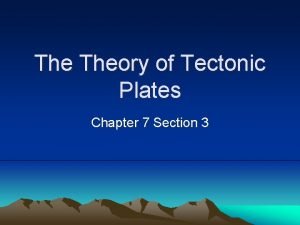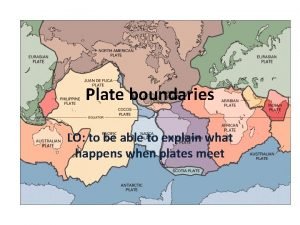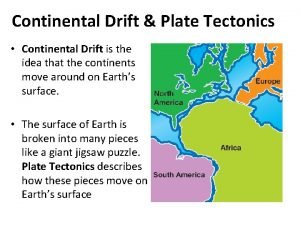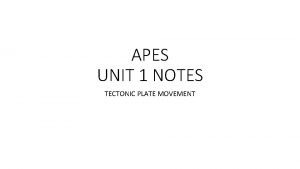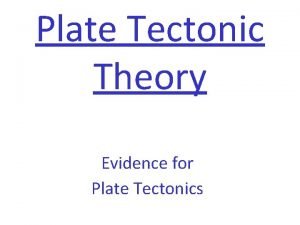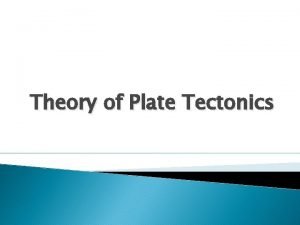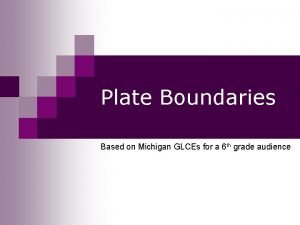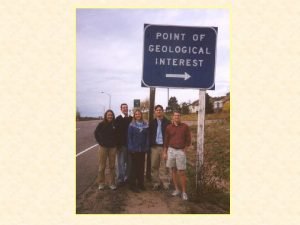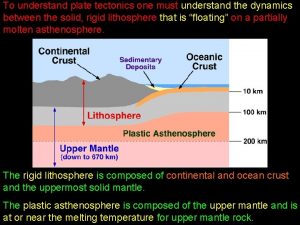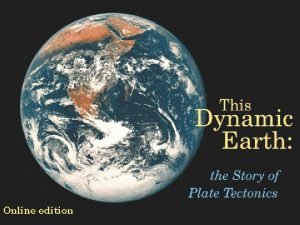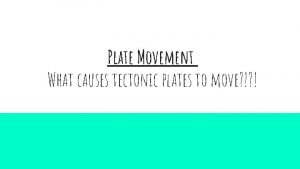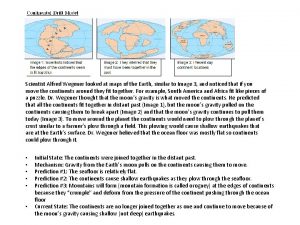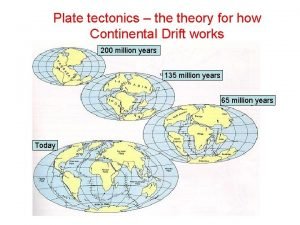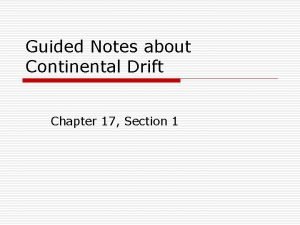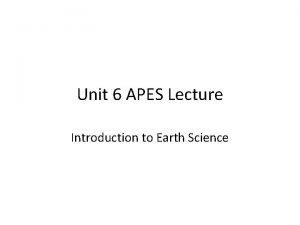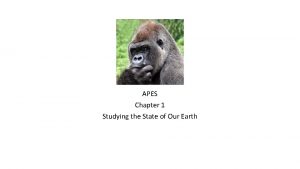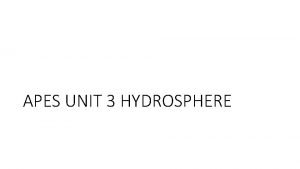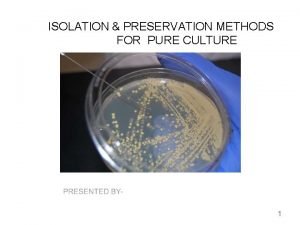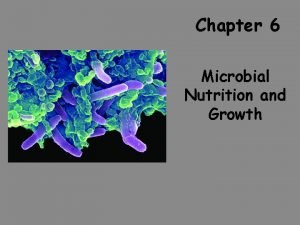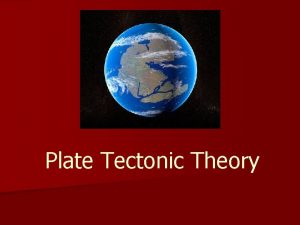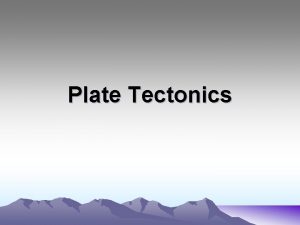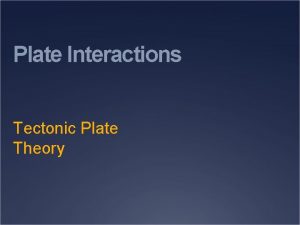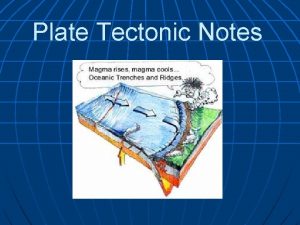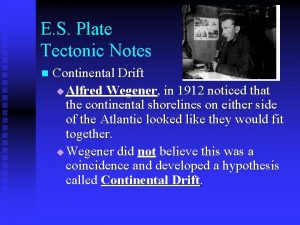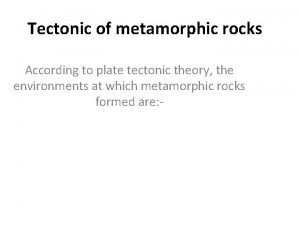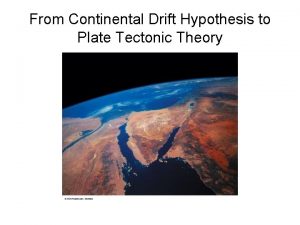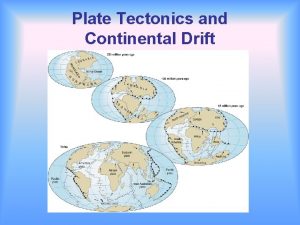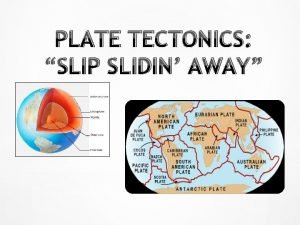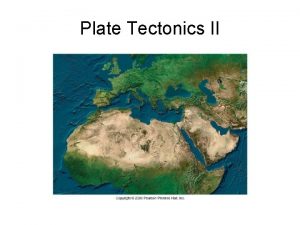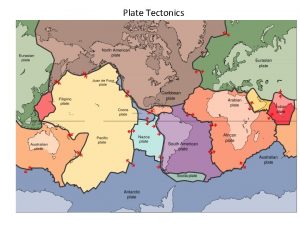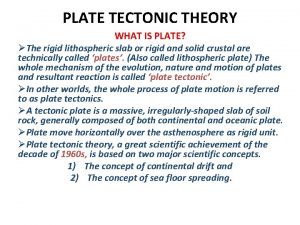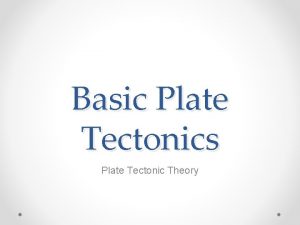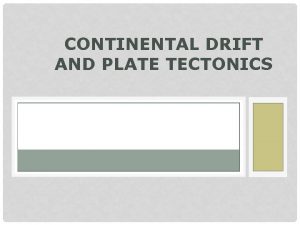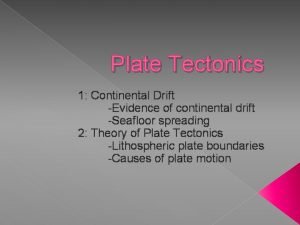APES UNIT 1 NOTES TECTONIC PLATE MOVEMENT CONTINENTAL





























- Slides: 29

APES UNIT 1 NOTES TECTONIC PLATE MOVEMENT

CONTINENTAL DRIFT THEORY ALFRED WEGENER proposed all continents originally formed from one landmass (PANGEA) EVIDENCE OF CONTINENTAL DRIFT: 1. Fossilized tropical plants in Greenland 2. Glacial landscapes in the tropics 3. Tropical regions show past polar climates 4. Continents fit together like puzzle pieces 5. Rock similarities in east coast of one continent and west coast of another

TECTONIC PLATES are large pieces of lithosphere that float on the asthenosphere. *There about 15 Tectonic Plates that drift slowly over the mantle *Oceanic plates are topped with *Oceanic plates are thinner and denser oceanic crust (mostly iron) *Continental plates are topped with *Continental plates are thicker and less dense (mostly silicon dioxide) continental crust

The largest plate is the Pacific Plate *The lithosphere is like a puzzle of movable parts

PLATE TECTONICS THEORY States that the Earth’s lithosphere is divided into plates that are in constant motion. It describes the formation and movement of the oceanic and continental plates. Plate Tectonics explains biological evolution, formation of mountains, volcanoes, earthquakes and volcanic eruptions. *some plates move 1 cm/yr

WHY DO PLATES MOVE? CONVECTION: is the process of heat transfer within the Earth that causes hot, less dense matter to rise and cool matter to sink which circulates material and forms Convection Currents. Mantle Convection occurs because of thermal gradient between core and crust. *Convection drives plates together and apart. The heat transfer provides the power.

HOT SPOTS are places where molten rock moves up to the lithosphere through plumes. 1. The mantle will create gaps where minerals crystalize. 2. Pressure and heat will cause matter to creep up through the gaps. *The high temperatures may result from radioactive decay of isotopes releasing heat

PLATE BOUNDARIES Plate Boundaries are the edges/margins of the plates. There are 3 types of Plate Boundary Interactions: 1. DIVERGENT BOUNDARY 2. CONVERGENT BOUNDARY 3. TRANSPORM FAULT BOUNDARY

DIVERGENT BOUNDARY *Where 2 plate move away from each other. *Causes a gap that can be filled with magma forming new lithosphere (part of Sea Floor Spreading) *Forms Ridges and Rift Valleys *Also create Fault zones (where 2 plates slide side-byside)

OCEANIC DIVERGENT BOUNDARY EXAMPLE: MID-ATLANTIC RIDGE

CONTINENTAL DIVERGENT BOUNDARY EXAMPLE: EAST AFRICAN RIFT VALLEYS

CONVERGENT BOUNDARY When 2 plates move towards each other. One plate will be pushed below the other forming trenches in the ocean and mountain range in the continents. Convergent boundaries cause SUBDUCTION. *SUBDUCTION= heavy plate is pushed under the lighter plate *SUBDUCTION ZONES= where subduction takes place *Subducted plate will melt in the asthenospere 3 kinds of Convergent Boundaries: 1. Oceanic-Oceanic convergence 2. Oceanic-Continental convergence 3. Continental-Continental convergence

OCEANIC-OCEANIC CONVERGENCE *creates trenches and Island Arcs *creates an Island arc Example: Japan

OCEANIC-CONTINENTAL CONVERGENCE *The denser oceanic plate will move underneath less dense continental plate (subduction). *Forms trenches, Volcanoes , Volcanic arc, Mountain ranges. EXAMPLE: ANDES MOUNTAIN RANGE IN SOUTH AMERICA

CONTINENTAL-CONTINENTAL CONVERGENCE • Mountain Ranges are created because of compression and uplifting. • EXAMPLE: The Himalayas in Asia

TRANSFORM FAULT BOUNDARY • When two plates slide from side to side, parallel • A fault (fracture) forms between plates • The friction and stress building causes Earthquakes • EXAMPLE: San Andreas Fault in California

COMPARING PLATE BOUNDARIES

REVIEW PLATE TECTONICS


EARTHQUAKES *OCCUR ALONG TRANSFORM PLATE BOUNDARIES *pressure builds up from the sliding friction and is released abruptly *the pressure released causes Seismic waves *FOCUS= the area where the energy starts and is released *EPICENTER= the area on the surface directly above the focus

SEISMIC WAVES Seismic waves travel outward from the focus in all directions. There are 2 classes of Seismic Waves: 1. BODY WAVES 2. SURFACE WAVES=travel along Earth’s surface , slower than Body waves (consist of Love waves and Rayleigh waves) BODY WAVES= travel through interior Earth *P waves through bedrock and are the fastest waves (the denser-the faster), travel parallel to direction of transmission. *S waves through uppermost layers of Earth. They travel slower (60%) and perpendicular

RICHTER SCALE *The magnitude (strength/energy) of an Earthquake is measured in logarithmic Richter Scale by a Seismograph onto a Seismogram. *The Richter Scale is really comparing amplitudes of waves *Each unit whole number represents an amplitude 10 X greater than the next smaller unit. (EX. 5. 0 is 10 X greater than 4. 0 ) (EX. 6. 0 is 100 X greater than 4. 0)

PRIMARY EFFECTS shaking ground damage to buildings permanent displacement damage to life SECONDARY EFFECTS rockslides flooding sinkholes fires tsunamis

TSUNAMIS VERY LARGE OCEANIC WAVES OR CAUSED THE MOVEMENT OF THE EARTH DURING AN EARTHQUAKE. WAVES CAN BE 33 FEET HIGH

VOLCANOES *A volcano is a mountain or hill formed from hot magma piling up on land *magma chamber forces molten magma up through Conduit (pipe) *ACTIVE VOLCANOES = currently erupted *DORMANT VOLCANOES = have never erupted in recorded history *EXTINCT VOLCANOES = will never erupt again *Volcanoes produce ejecta (chunks of lava rock), molten liquid lava, toxic gases, volcanic ash, *EXAMPLE: (1980) MT. Saint Helens (Washington state) removed trees, increase soil erosion, destroyed wildlife, polluted air, flooding from clogged rivers, 57 people died

HOT SPOT VOLCANOES – HAWAIIN ISLANDS As plate moves over a hot spot, heat from rising plume melts crust and forms another volcano

VOLCANIC GASES STEAM, CARBON DIOXIDE, SULFER DIOXIDE, HYDORGEN CHLORIDE Volcanoes affect the climate by releasing sulfur dioxide into the atmosphere which then converts to sulfate ions. Sulfate particles reflect shorter wavelengths of solar radiation which decreases the amount of sunlight reaching Earth. (lowers temp. ) EXAMPLE: (1992) Mt. Pinatubo erupted and decreased global temp. by 1 degree F

VOLCANO DIAGRAM

REDUCE EARTHQUAKE AND VOLCANO DAMAGE *examine history and calculate probability of event to prepare *map out locations *strengthen building codes *educate public
 The geological theory that states that pieces
The geological theory that states that pieces Continental drift vs plate tectonics
Continental drift vs plate tectonics What is the main cause of tectonic plate movement
What is the main cause of tectonic plate movement Blank tectonic plate map
Blank tectonic plate map 7 lithospheric plates
7 lithospheric plates V
V Plates that move towards each other
Plates that move towards each other Convergent boundary
Convergent boundary Oceanic oceanic convergent boundaries
Oceanic oceanic convergent boundaries How the continents fit together
How the continents fit together Tectonic plates interact at places called plate
Tectonic plates interact at places called plate Is michigan on a tectonic plate boundary
Is michigan on a tectonic plate boundary Fuji plate
Fuji plate Gizmos building pangea
Gizmos building pangea The plate tectonic system is driven by *
The plate tectonic system is driven by * What tectonic plate is south africa part of
What tectonic plate is south africa part of Type of fault
Type of fault What causes tectonic plates to move? *
What causes tectonic plates to move? * Plate tectonics vs continental drift
Plate tectonics vs continental drift Compare continental drift and plate tectonics
Compare continental drift and plate tectonics Magnetic reversals
Magnetic reversals Earths mantle
Earths mantle Continental drift notes
Continental drift notes Unit 6 apes
Unit 6 apes Apes unit 2
Apes unit 2 Apes chapter 1 review
Apes chapter 1 review Apes unit 8
Apes unit 8 Pour plate and spread plate difference
Pour plate and spread plate difference Culture pure
Culture pure Chapter 6 microbial nutrition and growth
Chapter 6 microbial nutrition and growth


